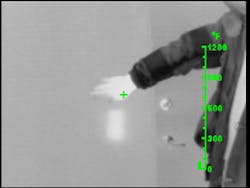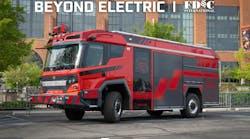In the April 2007 issue of Firehouse Magazine, the thermal imaging training article discusses tips for more effective overhaul. The reality is that a thermal imager can be a blessing to you in determining how far a fire may have extended. However, it can get frustrating if you don't understand what areas truly need overhaul. The Firehouse Magazine article gives tips for proper scene evaluation; online, we'll look at additional tools and skills at your disposal.
Manual Iris Control
This feature is only available on BST-based thermal imagers. While it is sometimes referred to as "thermal throttle," it is a user-controlled adjustment that can help in overhaul. A BST-based TI with a small knob near the lens has an internal iris that can be adjusted. For most operations, you want the iris in the fully open position. For overhaul, though, it can be helpful to slowly turn the iris control. This partially closes the iris, reducing the amount of heat reaching the infrared detector. As a result, items that are not extremely hot will fade to gray, while items that are hot will stay white. The images with this article illustrate this clearly. Prior to closing the iris, the entire ceiling appears to need overhaul. By reducing the amount of heat entering the imager, we have identified the hottest area as still white on the image. We can therefore concentrate our efforts on the hottest areas first.
Comparison to a Known Object
Sometimes, you will find hotspots with your TI outside of a fire area. For example, you could be investigating a smell of smoke or an electrical odor. In these situations, a hotspot may indicate the source of your problem. However, in these investigations, indiscriminately opening walls and machinery with your favorite axe can cause public relations problems.
For example, I spoke once with a fire department that responded to a house struck by lightning. On arrival, they found an outlet with scorch marks around it. A quick check with their new TI showed a bright white line running from floor to ceiling next to the outlet. They figured, "Hey, an electrical fire!" Thinking they would be heroes for keeping the fire from the attic, they opened the wall from ceiling to floor. They did not find an electrical fire; instead, they found the hot water pipe leading to the radiators on the second floor.
So, during investigations, it's critical to remember that when something is white on the TI display, it is not automatically a problem. It is important to get a point of comparison to determine just how hot something is. The easiest way to do that is with your partner. Have him place his hand near the hotspot and use that as a point of comparison. In the images below, you can see an outlet that appears hotter than the rest of the wall. However, when it is compared to a firefighter's hand, it is clear that the outlet is not overly warm.
Of course, if you have any doubt or concern, you can always do things the old-fashioned way...take off the face plate and look at the outlet to see if there is smoke or charring.
Cool it
Evaluating a room for overhaul right after knock-down can be very frustrating. Sometimes, it appears as though your TI is useless. Remember that the TI merely sees heat, and generates an image based on the amount of heat it sees. After you knock down the fire, everything in the room is still going to be hot, so your TI may show everything in the room as white on the display.
Don't get frustrated with the TI; it is just doing its job. You need to be smarter than the TI. If you are evaluating a room for overhaul, and the image is overwhelmingly white, try cooling some of the surfaces by spraying some water around the room. Briefly spraying the walls and ceiling will allow the water to absorb any moderate amounts of heat. This will cause those areas of the room to appear light gray on the display, while the hottest areas will still remain white. Then you can direct your efforts to the hottest areas first.
Overhaul is a great use for the TI, but it can also be challenging. By creatively using different features and functions of your TI, as well as some common sense and creativity, you can ensure that your TI is generating helpful images and that you are properly interpreting them. Keep practicing with them, and eventually you'll feel like a pro.
As always, be safe.
Jonathan Bastian is a Thermal Imaging Specialist for Bullard. He is certified as a thermal imaging instructor by the Law Enforcement Thermographers' Association (LETA). He is also the author of the FD Training Network "FireNotes" book, Thermal Imaging for the Fire Service. Bastian served 12 years on the North Park, IL, Fire Department, including the last three as a captain. He has taught classes on thermal imaging, rapid intervention teams and search and rescue operations. He is currently a police officer in Lexington, Kentucky. If you have questions about thermal imaging, please send them to [email protected].






